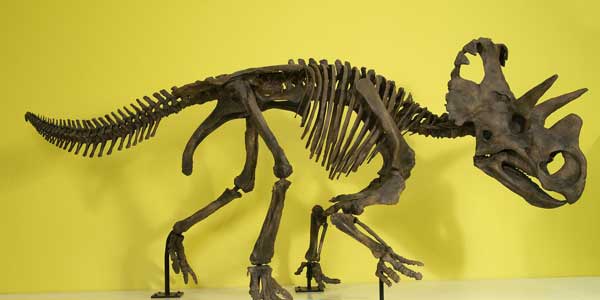
Toronto, Canada (BBN)-A dinosaur adorned with a horn-rimmed shield and a large horned nose has been discovered in Canada.
This herbivore ate low lying plants with its parrot-shaped beak, slicing them into fine pieces with many sharp, leaf-shaped teeth, reports BBC.
The 20ft (6m), one-tonne creature belongs to a family of horned dinosaurs called the Ceratopsidae.
It is related to the more famous Triceratops, and could help explain how it evolved.
The details of this new discovery are outlined in the journal PLoS One.
The new species is called Wendiceratops pinhornensis. This means "Wendy's horned face", named after Wendy Sloboda, a fossil hunter who discovered the fossil site in Southern Alberta, Canada in 2010.
The new species is one of the oldest of the large-bodied horned dinosaurs now known.
It lived in the Late Cretaceous some 79 million years ago. Its famous cousin Triceratops lived about ten million years later.
Over 200 bones were discovered at the site, making up the remains of about four dinosaurs.
The bones were thought to come from three adults and one juvenile.
They had a spectacular arrangement of horned hooks coming out of the backs of their skulls.
"Wendiceratops helps us understand the early evolution of skull ornamentation in an iconic group of dinosaurs characterized by their horned faces," says co-author David Evans of the Royal Ontario Museum in Toronto, Canada.
"The wide frill of Wendiceratops is ringed by numerous curled horns, the nose had a large, upright horn, and it's likely there were horns over the eyes too.
"The number of gnarly frill projections and horns makes it one of the most striking horned dinosaurs ever found," Evans says.
Aside from their spectacular horned frills, it was their horned noses that were of most interest to the scientists.
It helps them better understand how these horns evolved.
"Wendy" had all of the defining traits of a horned dinosaur. But its nose was medium length, between the earlier, smaller rounded horns of its predecessors and the taller horns of later relatives, says co-author Michael Ryan of the Cleveland Museum of Natural History, US.
"We're understanding what these animals looked like at the very base of their evolution," says Ryan.
We're finally starting to uncover their real diversity
These horns must have been beneficial for their survival. It might be that they were preferred by females, and males with bigger horns therefore won the best mates, says Ryan.
"We see something similar in living birds," he says. "Their different multi-coloured feathers are selected for."
The males may also have locked their horns together to gain access to territory or females.
We don't quite know what shape its horn was because the team only uncovered small fragments of it.
However, what is clear is that its nasal bone would have held an upright facing horn.
This type of nose horn could have evolved twice: once in the group that includes Wendiceratops, which was characterised by short frills around the neck, and again in the group that includes Triceratops, which had longer frills.
This discovery follows in the footsteps of several other recently unearthed horned dinosaurs.
A particularly iconic discovery, named in 2013, was the Nasutoceratops titusi, which translates at "big nose horn-faced" due to its gigantic nose and long horn.
In late 2014, another team described a buffalo-sized cousin of the well-known Triceratops.
"We're finally starting to uncover their real diversity," says Ryan. "They had a much wider and diverse array and ornamentation of their skulls than we previously thought."
BBN/SK/AD